Our good friends down the road were treating us to a nice meal one Friday when their eldest son called to say his lady-friends car was making some horrible noises and they would have to amend their weekend plans. Being a bit of a petrol head, I said to bring it over for a quick look the following morning. The car turned up the next morning and I have to say it announced its self in good time.
The car had already been to the local mechanic for a 'check-up' and he had diagnosed a faulty 'Exhaust Gas Recirculation' (EGR) valve and quoted them 300 pounds sterling to replace it. All the diagnostic work had been done by computer; I don't think he even lifted the bonnet!
A quick check under the bonnet showed that the EGR valve was really accessible, so I checked on 'The Internet' to ensure there was nothing that was going to catch me out before having a go at cleaning it, rather than replacing it on a car that had only done 83,000 miles. I also checked on the price and found they were around 130 pounds sterling to replace and given the ease of the task, that's an hour's job, and 170 pounds sterling per hour in labour!
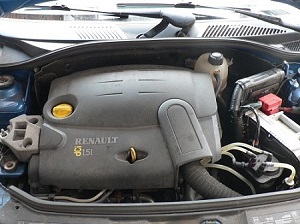
The first task is to remove the engine cover which just pops off (though I did remove then replace the oil filler cap as I thought that secured it).
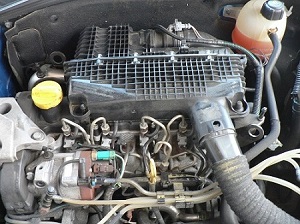
There are two tabs that connect it to the intake air trunking, pressing them in with your fingers should release them, then undo the Jubilee clip at the manifold end.
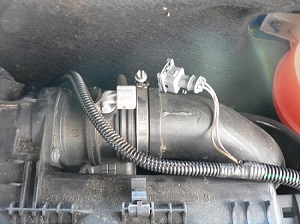
Don't forget to disconnect the intake air temp sensor, the grey connector at the top of the image. Then release the EGR valve wiring from its clip.
Release the airbox by pulling against the rubber bungs. In the case of this car there was just one remaining, which is part of the reason it was so noisy at idle. A quick check inside showed the air filter to be in a clean state.
Removing the air box shows just how accessible the EGR valve is, follow the black loom to the valve which is the grey chamber just above the long piece of pipework.

The EGR valve is secured with three 10mm bolts which are easy to get to and took a couple of minutes to remove ("That will be 50 pounds sterling please!").
I have to admit it did take a good few minutes to remove the valve, due to its tight fit and carbon build up, but 170 pounds sterling in labour? "Your 'avin' a tin barf mate!".
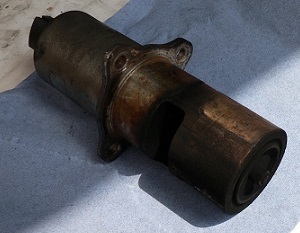
After removing it, I soaked the sooty end in a jug of petrol while I cleaned out the chamber in which it sits.
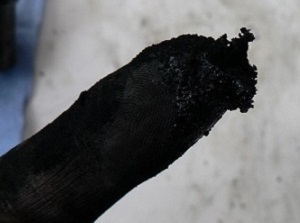
This took rather longer than expected because it was FILTHY!.
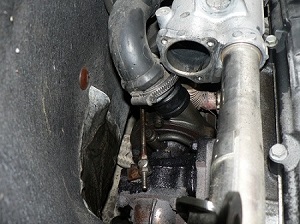
While poking my finger into the intake I noticed the reason why the car lacked power and was so noisy.
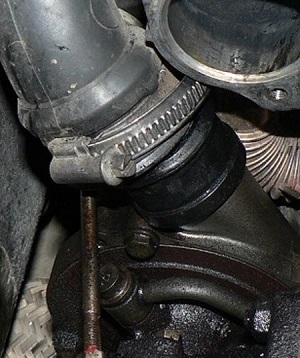
I am pretty sure that the pipework should not look like this from the turbo output to the manifold
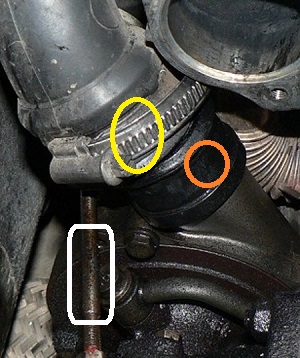
In case the image is not clear enough in your mind, the section of the inlet manifold hose encompassed by the yellow oval, should be located on the stub of the turbo outlet, marked with the orange circle. At present, it is just resting on top of it.
I noticed that the rod (white marking) that connects the waste gate to the waste gate pressure chamber appears to be rubbing against the bottom of the hose. Could this have been incorrectly assembled and has worked the hose off the turbo outlet stub?
The other thing I was worried about was the fact that I could not move the waste gate valve by hand, though I am by far an expert on turbos.
I did manage to get the hose back on, but I was far from happy that it had fixed the problem and my scepticism was justified when the owner took it out for a test drive and the hose blew off again.
As I explained to the lady owner, it could be that the waste gate had seized in the half open position, which it appears to be in. This would cause a lack of boost at low revs and make the car sluggish, but then when the exhaust gas volume builds up and turbo boost increases, the waste gate should move to fully open, bleeding off excess exhaust gas volume and limiting the boost. As the waste gate is seized (?) this is not the case and the boost pressure increased until the intake trunking cannot cope, and the pipe gets blown off.
With no means of measuring boost pressure, I could not confirm my suspicions.
With my limited knowledge of the type, I handed the car back with a write up of what I had found. If I had the tools, I would have re-fitted the hose and plumbed in a boost pressure gauge to show what was happening with the turbo.
As the car is going back to the same mechanic on Monday (June 2011), it will be nice to see what he says when he reads my notes. It may indeed need a new turbo, let's see what markup he can make on that shall we?